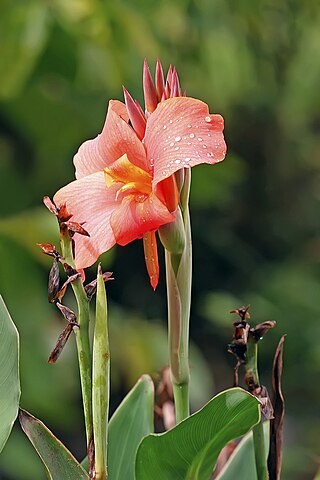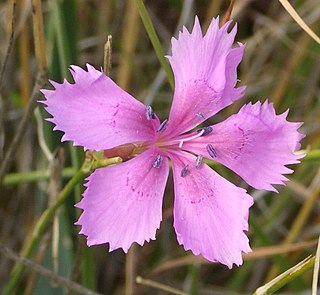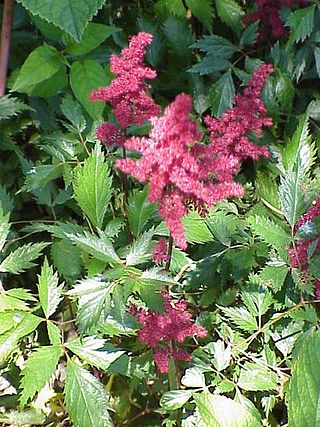Related Research Articles

Canna or canna lily is the only genus of flowering plants in the family Cannaceae, consisting of 10 species. All of the genus's species are native to the American tropics and were naturalized in Europe, India and Africa in the 1860s. Although they grow native to the tropics, most cultivars have been developed in temperate climates and are easy to grow in most countries of the world, as long as they receive at least 6–8 hours average sunlight during the summer, and are moved to a warm location for the winter. See the Canna cultivar gallery for photographs of Canna cultivars.

Dianthus caryophyllus, commonly known as carnation or clove pink, is a species of Dianthus native to the Mediterranean region. Its exact natural range is uncertain due to extensive cultivation over the last 2,000 years. Carnations are prized for their vibrant colors, delicate fringed petals, and enchanting fragrance.

Penstemon, the beardtongues, is a large genus of roughly 280 species of flowering plants native to North America from northern Canada to Central America. It is the largest genus of flowering plants endemic to North America. As well as being the scientific name, penstemon is also widely used as a common name for all Penstemon species alongside beardtongues.

Dianthus is a genus of about 340 species of flowering plants in the family Caryophyllaceae, native mainly to Europe and Asia, with a few species in north Africa and in southern Africa, and one species in arctic North America. Common names include carnation, pink and sweet william.

Alstroemeria, commonly called the Peruvian lily or lily of the Incas, is a genus of flowering plants in the family Alstroemeriaceae. They are all native to South America, although some have become naturalized in the United States, Mexico, Australia, New Zealand, Madeira and the Canary Islands. Almost all of the species are restricted to one of two distinct centers of diversity: one in central Chile, the other in eastern Brazil. Species of Alstroemeria from Chile are winter-growing plants, while those of Brazil are summer growing. All are long-lived perennials except A. graminea, a diminutive annual from the Atacama Desert of Chile.

Osteospermum, is a genus of flowering plants belonging to the Calenduleae, one of the smaller tribes of the sunflower/daisy family Asteraceae. They are known as the daisybushes or African daisies. Its species have been given several common names, including African daisy, South African daisy, Cape daisy and blue-eyed daisy.

Hyacinthus orientalis, the common hyacinth, garden hyacinth or Dutch hyacinth, is a species of flowering plant in the family Asparagaceae, subfamily Scilloideae, native to southwestern Asia, southern and central Turkey, northwestern Syria, Lebanon and northern Palestine. It was introduced to Europe in the 16th century. It is widely cultivated everywhere in the temperate world for its strongly fragrant flowers which appear exceptionally early in the season, and frequently forced to flower at Christmas time.

Hosta is a genus of plants commonly known as hostas, plantain lilies and occasionally by the Japanese name gibōshi. Hostas are widely cultivated as shade-tolerant foliage plants. The genus is currently placed in the family Asparagaceae, subfamily Agavoideae, and is native to northeast Asia. Like many "lilioid monocots", the genus was once classified in the Liliaceae. The genus was named by Austrian botanist Leopold Trattinnick in 1812, in honor of the Austrian botanist Nicholas Thomas Host. In 1817, the generic name Funkia was used by German botanist Kurt Sprengel in honor of Heinrich Christian Funck, a collector of ferns and alpines; this was later used as a common name and can be found in some older literature.

Dianthus barbatus, the sweet William, is a species of flowering plant in the family Caryophyllaceae, native to southern Europe and parts of Asia. It has become a popular ornamental garden plant. It is a herbaceous biennial or short-lived perennial plant growing to 13–92 cm tall, with flowers in a dense cluster of up to 30 at the top of the stems. Each flower is 2–3 cm diameter with five petals displaying serrated edges. Wild plants produce red flowers with a white base, but colours in cultivars range from white, pink, red, and purple to variegated patterns. The exact origin of its English common name is unknown but first appears in 1596 in botanist John Gerard's garden catalogue. The flowers are edible and may have medicinal properties. Sweet William attracts bees, birds, and butterflies.

Camellia japonica, known as common camellia, or Japanese camellia, is a species of Camellia, a flowering plant genus in the family Theaceae. There are thousands of cultivars of C. japonica in cultivation, with many colors and forms of flowers. Despite its common name, it is native to China, not Japan. The cultivation of Camellia japonica also started in China. Its widespread cultivation can be traced back to the Song Dynasty, when 15 varieties of Camellia japonica were recorded in literature. It was later introduced to Japan. It grows in forests, at altitudes of around 300–1,100 metres (980–3,600 ft).

Erica vagans, the Cornish heath or wandering heath, is a species of flowering plant in the family Ericaceae, native to Ireland, Cornwall, western France and Spain. It is a vigorous, spreading, evergreen heather reaching 75 cm (30 in) tall and wide, with pink flowers borne in racemes 14 cm (6 in) long in summer and autumn. The Latin specific epithet vagans literally means "wandering"; in this context it means "widely distributed".

Dianthus deltoides, the maiden pink, is a species of Dianthus native to most of Europe and western Asia. It can also be found in many parts of North America, where it is an introduced species.

Astilbe is a genus of 18 species of rhizomatous flowering plants within the family Saxifragaceae, native to mountain ravines and woodlands in Asia and North America. Some species are known by the common names false goat's beard and false spirea.

Dianthus gratianopolitanus, commonly known as the Cheddar pink or clove pink, is a species of plant in the family Caryophyllaceae. It is a herbaceous perennial, hardy to zones 4–8. It grows to a height of 0.5 to 1 feet, blooming from May to June. Flowers are fragrant and rose pink. Grows best in full sun, and has medium water requirements. Overwatering or poor drainage leads to crown rot, and plants do not tolerate wet winter soil conditions.

Camellia sasanqua, with common name sasanqua camellia, is a species of Camellia native to southern Japan. It is usually found growing up to an altitude of 900 m (3,000 ft).

Escallonia is a genus of shrubs and trees in the family Escalloniaceae. They are native to North and South America.

Aster amellus, the European Michaelmas daisy, is a perennial herbaceous plant and the type species of the genus Aster and the family Asteraceae.

Acer palmatum, commonly known as Japanese maple, palmate maple, or smooth Japanese maple (Korean: danpungnamu, 단풍나무, Japanese: irohamomiji, イロハモミジ, or momiji,, is a species of woody plant native to Korea, Japan, China, eastern Mongolia, and southeast Russia. Many different cultivars of this maple have been selected and they are grown worldwide for their large variety of attractive forms, leaf shapes, and spectacular colors.
References
- ↑ "RHS Plant Selector - Dianthus 'Alfriston'" . Retrieved 14 February 2020.
- ↑ "RHS Plant Selector - Dianthus 'Anders Kath Phillips'" . Retrieved 14 February 2020.
- ↑ "RHS Plant Selector - Dianthus 'Ann Franklin'" . Retrieved 14 February 2020.
- ↑ "RHS Plant Selector - Dianthus 'Becky Robinson'" . Retrieved 14 February 2020.
- ↑ "RHS Plant Selector - Dianthus 'Betty Morton'" . Retrieved 14 February 2020.
- ↑ "RHS Plant Selector - Dianthus 'Brian Tumbler'" . Retrieved 14 February 2020.
- ↑ "RHS Plant Selector - Dianthus 'Brilliant Star'" . Retrieved 14 February 2020.
- ↑ "RHS Plant Selector - Dianthus 'Bryony Lisa'" . Retrieved 14 February 2020.
- ↑ "RHS Plant Selector - Dianthus 'Carmine Letitia Wyatt'" . Retrieved 14 February 2020.
- ↑ "RHS Plant Selector - Dianthus 'Chesswood Barbara Arif'" . Retrieved 14 February 2020.
- ↑ "RHS Plant Selector - Dianthus 'Chesswood Lidgett'" . Retrieved 14 February 2020.
- ↑ "RHS Plant Selector - Dianthus 'Chesswood Margaret Alison'" . Retrieved 14 February 2020.
- ↑ "RHS Plant Selector - Dianthus 'Chris Crew'" . Retrieved 14 February 2020.
- ↑ "RHS Plant Selector - Dianthus 'Claret Joy'" . Retrieved 14 February 2020.
- ↑ "RHS Plant Selector - Dianthus 'Coronation Ruby'" . Retrieved 14 February 2020.
- ↑ "RHS Plant Selector - Dianthus 'Cranmere Pool'" . Retrieved 14 February 2020.
- ↑ "RHS Plant Selector - Dianthus 'Dainty Dame'" . Retrieved 14 February 2020.
- ↑ "RHS Plant Selector - Dianthus 'David Russell'" . Retrieved 14 February 2020.
- ↑ "RHS Plant Selector - Dianthus 'David Saunders'" . Retrieved 14 February 2020.
- ↑ "RHS Plant Selector - Dianthus 'Devon Dove'" . Retrieved 14 February 2020.
- ↑ "RHS Plant Selector - Dianthus 'Devon Flavia'" . Retrieved 14 February 2020.
- ↑ "RHS Plant Selector - Dianthus 'Devon Wizard'" . Retrieved 14 February 2020.
- ↑ "RHS Plant Selector - Dianthus 'Diane'" . Retrieved 14 February 2020.
- ↑ "RHS Plant Selector - Dianthus alpinus" . Retrieved 14 February 2020.
- ↑ "RHS Plant Selector - Dianthus deltoides" . Retrieved 14 February 2020.
- ↑ "RHS Plant Selector - Diathus gratianopolitanus" . Retrieved 14 February 2020.
- ↑ "RHS Plant Selector - Dianthus 'Doris'" . Retrieved 14 February 2020.
- ↑ "RHS Plant Selector - Dianthus 'Eileen Neal'" . Retrieved 14 February 2020.
- ↑ "RHS Plant Selector - Dianthus 'Eileen O'Connor'" . Retrieved 14 February 2020.
- ↑ "RHS Plant Selector - Dianthus 'Evening Star'" . Retrieved 14 February 2020.
- ↑ "RHS Plant Selector - Dianthus 'Flanders'" . Retrieved 14 February 2020.
- ↑ "RHS Plant Selector - Dianthus 'Golden Cross'" . Retrieved 14 February 2020.
- ↑ "RHS Plant Selector - Dianthus 'Gran's Favourite'" . Retrieved 14 February 2020.
- ↑ "RHS Plant Selector - Dianthus 'Grey Dove'" . Retrieved 14 February 2020.
- ↑ "RHS Plant Selector - Dianthus 'Hannah Louise'" . Retrieved 14 February 2020.
- ↑ "RHS Plant Selector - Dianthus 'Haytor Rock'" . Retrieved 14 February 2020.
- ↑ "RHS Plant Selector - Dianthus 'Haytor White'" . Retrieved 14 February 2020.
- ↑ "RHS Plant Selector - Dianthus 'Hazel Ruth'" . Retrieved 14 February 2020.
- ↑ "RHS Plant Selector - Dianthus 'Houndspool Cheryl'" . Retrieved 14 February 2020.
- ↑ "RHS Plant Selector - Dianthus 'Houndspool Ruby'" . Retrieved 14 February 2020.
- ↑ "RHS Plant Selector - Dianthus 'Incas'" . Retrieved 14 February 2020.
- ↑ "RHS Plant Selector - Dianthus 'India Star'" . Retrieved 14 February 2020.
- ↑ "RHS Plant Selector - Dianthus 'Inshriach Dazzler'" . Retrieved 14 February 2020.
- ↑ "RHS Plant Selector - Dianthus 'Irene Della-Torré'" . Retrieved 14 February 2020.
- ↑ "RHS Plant Selector - Dianthus 'Jean Knight'" . Retrieved 14 February 2020.
- ↑ "RHS Plant Selector - Dianthus alpinus 'Joan's Blood'" . Retrieved 14 February 2020.
- ↑ "RHS Plant Selector - Dianthus 'John Sandall'" . Retrieved 14 February 2020.
- ↑ "RHS Plant Selector - Dianthus 'Joy'" . Retrieved 14 February 2020.
- ↑ "RHS Plant Selector - Dianthus 'Kathleen Hitchcock'" . Retrieved 14 February 2020.
- ↑ "RHS Plant Selector - Dianthus 'Kesteven Kirkstead'" . Retrieved 14 February 2020.
- ↑ "RHS Plant Selector - Dianthus 'Kristina'" . Retrieved 14 February 2020.
- ↑ "RHS Plant Selector - Dianthus 'La Bourboule'" . Retrieved 14 February 2020.
- ↑ "RHS Plant Selector - Dianthus Lady Madonna=Wp04 Idare" . Retrieved 14 February 2020.
- ↑ "RHS Plant Selector - Dianthus 'Letitia Wyatt'" . Retrieved 14 February 2020.
- ↑ "RHS Plant Selector - Dianthus Lily the Pink='Wp05' Idare" . Retrieved 14 February 2020.
- ↑ "RHS Plant Selector - Dianthus 'Linfield Dorothy Perry'" . Retrieved 14 February 2020.
- ↑ "RHS Plant Selector - Dianthus 'Linfield Kathy Booker'" . Retrieved 14 February 2020.
- ↑ "RHS Plant Selector - Dianthus 'Maisie Neal'" . Retrieved 14 February 2020.
- ↑ "RHS Plant Selector - Dianthus 'Mambo'" . Retrieved 14 February 2020.
- ↑ "RHS Plant Selector - Dianthus 'Maureen Lambert'" . Retrieved 14 February 2020.
- ↑ "RHS Plant Selector - Dianthus 'Michael Saunders'" . Retrieved 14 February 2020.
- ↑ "RHS Plant Selector - Dianthus 'Milky Way'" . Retrieved 14 February 2020.
- ↑ "RHS Plant Selector - Dianthus 'Monica Wyatt'" . Retrieved 14 February 2020.
- ↑ "RHS Plant Selector - Dianthus 'Moulin Rouge'" . Retrieved 14 February 2020.
- ↑ "RHS Plant Selector - Dianthus 'Natalie Saunders'" . Retrieved 14 February 2020.
- ↑ "RHS Plant Selector - Dianthus 'Neon Star'" . Retrieved 14 February 2020.
- ↑ "RHS Plant Selector - Dianthus 'Nichola Ann'" . Retrieved 14 February 2020.
- ↑ "RHS Plant Selector - Dianthus 'Night Star'" . Retrieved 14 February 2020.
- ↑ "RHS Plant Selector - Dianthus 'Peter Wood'" . Retrieved 14 February 2020.
- ↑ "RHS Plant Selector - Dianthus 'Pike's Pink'" . Retrieved 14 February 2020.
- ↑ "RHS Plant Selector - Dianthus 'Pixie Star'" . Retrieved 14 February 2020.
- ↑ "RHS Plant Selector - Dianthus 'Prado Mint'" . Retrieved 14 February 2020.
- ↑ "RHS Plant Selector - Dianthus 'Red Star'" . Retrieved 14 February 2020.
- ↑ "RHS Plant Selector - Dianthus Romance='Wp09 Wen04'" . Retrieved 14 February 2020.
- ↑ "RHS Plant Selector - Dianthus 'Rose Joy'" . Retrieved 14 February 2020.
- ↑ "RHS Plant Selector - Dianthus 'Rose Monica Wyatt'" . Retrieved 14 February 2020.
- ↑ "RHS Plant Selector - Dianthus 'Sandra Neal'" . Retrieved 14 February 2020.
- ↑ "RHS Plant Selector - Dianthus Slap 'n' Tickle='Wp05 Pp22'" . Retrieved 14 February 2020.
- ↑ "RHS Plant Selector - Dianthus 'Sandra Neal'" . Retrieved 14 February 2020.
- ↑ "RHS Plant Selector - Dianthus 'Tamsin Fifield'" . Retrieved 14 February 2020.
- ↑ "RHS Plant Selector - Dianthus Tickled Pink='Devon Pp11'" . Retrieved 14 February 2020.
- ↑ "RHS Plant Selector - Dianthus 'Uncle Teddy'" . Retrieved 14 February 2020.
- ↑ "RHS Plant Selector - Dianthus 'Valda Wyatt'" . Retrieved 14 February 2020.
- ↑ "RHS Plant Selector - Dianthus Viana=Kovian" . Retrieved 14 February 2020.
- ↑ "RHS Plant Selector - Dianthus 'Whatfield Cancan'" . Retrieved 14 February 2020.
- ↑ "RHS Plant Selector - Dianthus 'Whatfield Magenta'" . Retrieved 14 February 2020.
- ↑ "RHS Plant Selector - Dianthus 'White Joy'" . Retrieved 14 February 2020.
- ↑ "RHS Plant Selector - Dianthus 'Widecombe Fair'" . Retrieved 14 February 2020.